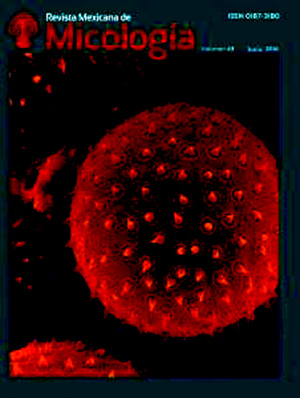Use of native Basidiomycetes in the biotransformation of buffel grass (Cenchrus ciliaris) to improve the nutritional quality
DOI:
https://doi.org/10.33885/sf.2016.3.1153Keywords:
cellulases, laccases, Trametes spp., xylanasesAbstract
The aim of the present work was to evaluate the capability of three native basidiomycetes from the Northeast region of Mexico to produce
enzymes able to break down the main components of plant cell wall and their effect on the biotransformation of buffel grass (Cenchrus ciliaris)
in order to increase its nutritional quality. Lignocellulolytic potential was evaluated on solid media and the biotransformation of buffel
grass slabs was performed. Titers of cellulases, xylanases, and laccases were determined, as well as the fiber and protein content in the slabs.
The basidiomycete reduced neutral detergent fiber (NDF) content on treated slabs. Trametes maxima CU1 showed the greatest lignolytic capability
reducing 14.24% the lignin content of grass. Pycnoporus sanguineus CS2 and T. hirsuta CS5 reduced the content of cellulose (21.6 and
19.8% respectively), and hemicellulose (17.1 and 14.2% respectively) in comparison to the control. Treatment with fungi P. sanguineus CS2
and T. hirsuta CS5 increased in 31% the protein content of grass. These results denote that basidiomycetes increased nutrients bioavailability
of buffel grass, hence increasing its nutritional quality
Downloads
Downloads
How to Cite
Issue
Section
License
Copyright notice
Open access policy
The authors who publish in this journal accept the following conditions:
In accordance with copyright laws, Scientia Fungorum recognizes and respects the authors’ moral rights, as well as the ownership of property rights, which will be transferred to the journal for dissemination in open access. Scientia Fungorum does not charge for submission and processing of articles for publication.
All the texts published by Scientia Fungorum –with no exception– are distributed under a Creative Commons License Attribution-NonCommercial-ShareAlike 4.0 International (CC BY-NC-SA 4.0), which allows third parties to use the publication as long as the work’s authorship and its first publication in this journal are mentioned.
The authors can enter into independent and additional contractual agreements for the nonexclusive distribution of the version of the article published in Scientia Fungorum (for example include it into an institutional repository or publish it in a book) as long as it is clearly and explicitly indicated that the work was published for the first time in Scientia Fungorum.
For all the above, the authors shall send the form of Letter-transfer of Property Rights for the first publication duly filled in and signed by the author(s). This form must be sent as a complementary file.
This work is licensed under a Creative Commons Attribution-NonCommercial-ShareAlike 4.0 International license (CC-By-NC-SA 4.0).



